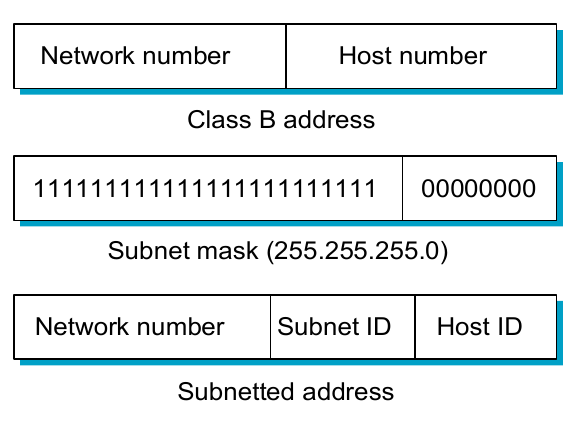4. Subnetting #
IP Address Problem #
- Class A and B networks are too big
- Very few LANs have close to 64,000 hosts
- For electrical/LAN limitations, performance, or administrative reasons
- Address space depletion
- Running out of Class A and B addresses, since Class C is too small for most domains
- Clsas B sparsely populated, but people refuse to give it back
- Large forwarding tables
- 2 million possible Class C groups
Solutions #
- Short-term solutions:
- Subnetting
- Classless Inter-Domain Routing (CIDR), RFC 1518
- New allocation policy (RFC 2050)
- Private IP addresses set aside for intranets
- Long-term solution:
- IPv6, with much bigger address space (128-bit)
Subnet and Classless Addressing #
- Not part of the original scheme
- Invented to prevent address exhaustion
- Allows the boundary between prefix and suffix to occur on an arbitrary bit boundary
- Requires auxiliary information to indentify the boundary
Subnetting #
- Goal: to extend address space
- Subnet addressing introduces another hierarchical level
- Transparent to remote networks
- Simplifies management of multiplicity of LANs
- Technique:
- Assign single network prefix to site
- Divide suffix into two parts: network at site and host
- Typical use: divide Class B addresses
Address Mask #
- Accompanies the IP address
- 32-bit binary value
- Specifies prefix/suffix boundary
- 1s cover prefix (network)
- 0s cover suffix (host)
- Masking used to find subnet number
- Performing a bitwise logical AND operation between the IP address and the subnet mask results in the Network Address or Number
- For example: the Class B mask is 255.255.0.0
Subnetting (Continued) #
- Take a network address and break it up into subnets that can be assigned to individual physical networks
- Define a subnet mask to help create a new level of hierarchy in the addressing scheme
- The bitwise AND of the subnet mask with the full address gives the subnet number
- Group physically close networks to share a single Network ID
- Subnetting is not visible to the outside world. An organisation decides internally how to implement subnetting

Subnetting Example #
- Assume an organisation was assigned address 150.100
- Assume < 100 hosts per subnet
- So we need 7 host bits
- Therefore network mask is
11111111 11111111 11111111 10000000or255.255.255.128 - Apply the subnet mask to IP addresses to find corresponding subnet
Example: find subnet for 150.100.12.176
IP Address : 10010110 01100100 00001100 10110000
Mask : 11111111 11111111 11111111 10000000
AND : 10010110 01100100 00001100 10000000
Subnet : 150.100.12.128
Calculating Available Subnets/Hosts #
- To calculate the number of subnets (avoid the zero and broadcast subnet) or nodes, use the formula: 2n - 2, where n is the number of bits in either field
- To calculate the number of subnets when using Classless routing protocol, RIP V2, EIGRP, or OSPF, use: 2n
- Number of subnets * number of nodes per subnet = total number of nodes in class
Example 1 #
IP Address : 10001100.10110011.11011100.11001000 140.179.220.200
Mask : 11111111.11111111.11100000.00000000 255.255.224.000
AND : 10001100.10110011.11000000.00000000 140.179.192.000
- 3-bit subnet mask is used
- Subnet address is calculated to be 140.179.192.000, as shown above
- Number of subnets = 23 - 2 = 6
Example 2 #
- You are assigned a Class C network number:
200.133.175.0 - You want to utilise this network across multiple small groups within your organisation
- Number of nodes you’ll get without subnetting: 28 - 2 = 254
- You decide to break the network into 14 smaller subnets
- To get 14 subnets, you need a subnet mask of 4 bits
- Hosts per subnet: 24 - 2 = 14
Routing with Subnets #
- IP layer in hosts and routers maintain a routing table
- Originating host: to send an IP packet, consult routing table:
- If destination host is in the same network, send packet directly uing appropriate network interface
- Otherwise, send packet indirectly; typically, routing table indicates a default router
- Router: Examine IP destination address in arriving packet:
- If destination IP address not own, router consults routing table to determine next-hop and associated network interface, then forwards packet
Routing Table Example #
| SubnetNumber | SubnetMask | NextHop |
|---|---|---|
| 128.96.34.0 | 255.255.255.128 | eth0 |
| 128.96.34.128 | 255.255.255.128 | eth1 |
| 128.96.33.0 | 255.255.255.0 | R2 |
Additional Points #
- The subnet mask does not need to align on byte boundaries
- It is possible to put multiple subnets on the same physical network, but hosts may then have to go through a router to talk to each other
- From outside the subnetted domain, the whole thing is viewed as a single network. For this reason, subnets should be kept geographically close